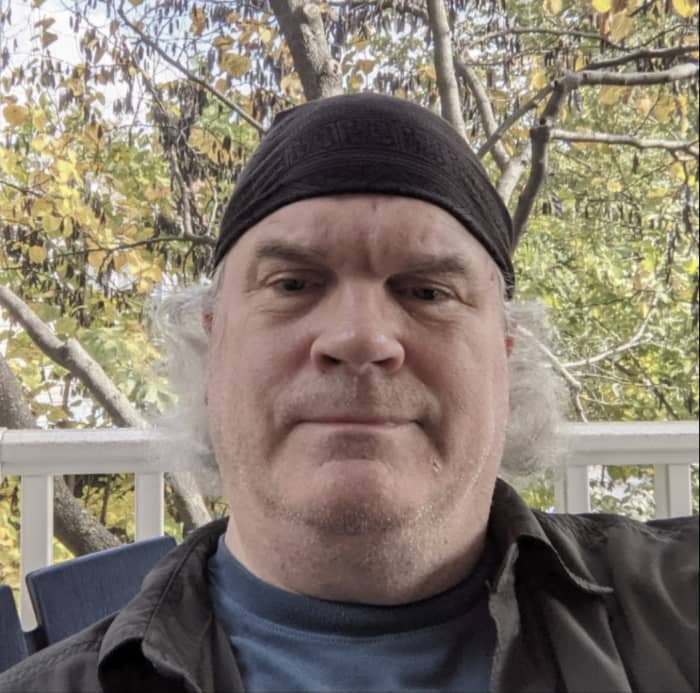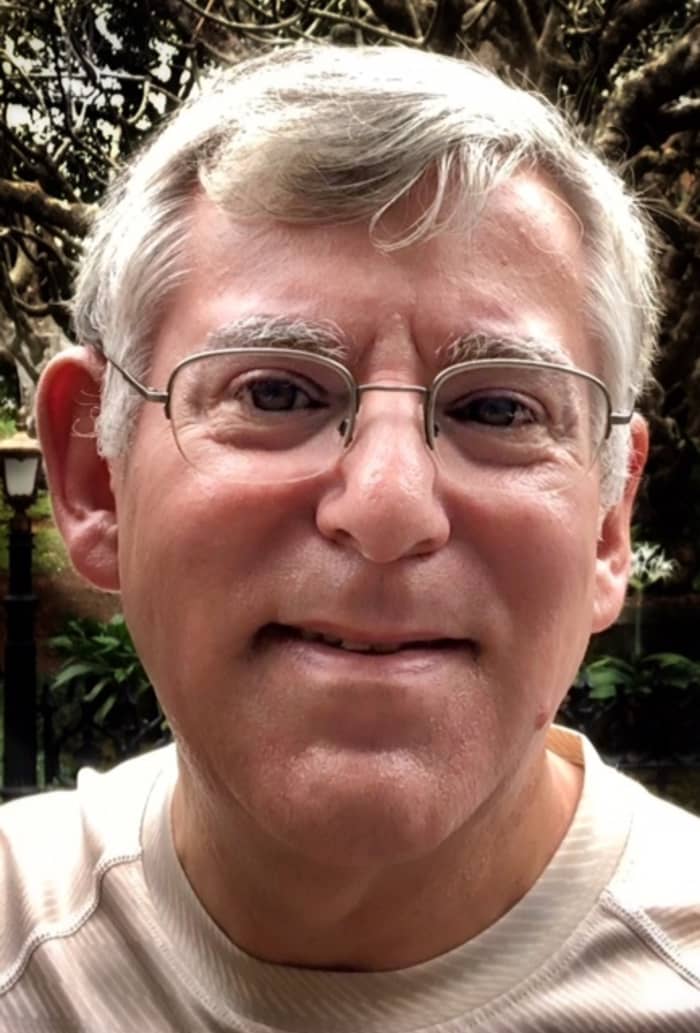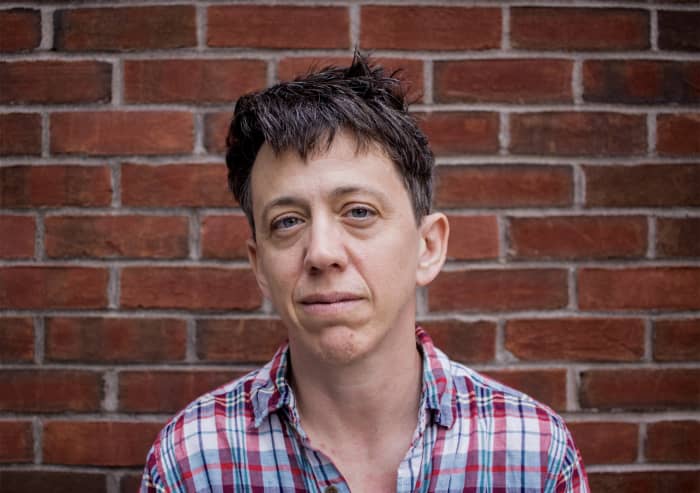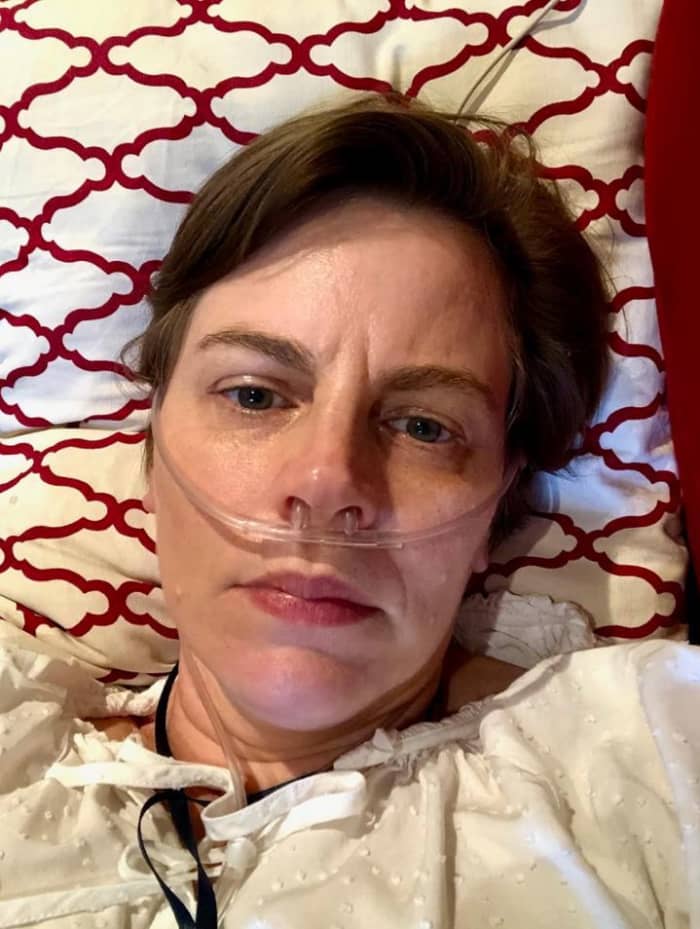Two years ago, Kathy Spencer, a 58-year-old math teacher, motorcycle rider and mother of two, planned to guide middle school students through geometry well into her 70s.
But now Spencer, from Kensington, Conn., is facing the real possibility that long COVID will keep her from ever entering a classroom again. She still needs supplemental oxygen, and has difficulty speaking as a result of the hypoxia, or lack of oxygen reaching her brain. She suffers tremors in her head, arms and legs, which can be triggered by talking, and she experiences debilitating fatigue.
“We’re meeting with our financial planner and our accountant to make some really tough decisions about how my husband and I need to change our financial goals and plans,” Spencer said. “It’s been a slow recognition that this isn’t just gonna go away.”
Spencer’s idea of what her life would be like in her 70s has radically changed. She is one of the millions of people who have been suffering post-COVID conditions for weeks, months, or even years after their initial COVID-19 infections. This is commonly called long COVID, and the symptoms include difficulty breathing or shortness of breath; tiredness or fatigue; symptoms that get worse after physical or mental activity; and difficulty thinking or concentrating, sometimes referred to as brain fog. Some of these patients, often called long haulers, also experience damage to multiple organs, including the brain, heart, lungs and kidneys.
Long COVID has kept Kathy Spencer on supplemental oxygen for two years. She wants to get back to work — and riding her motorcycle — but is realizing “this isn’t just gonna go away.”
Kathy Spencer
Studies estimate that between one-quarter to one-third of COVID-19 patients develop long COVID — regardless of whether these long haulers had severe illness, mild illness or showed no symptoms at all during their initial COVID infection. So with 81.5 million COVID-19 cases and counting reported in the U.S., this suggests that more than 20 million Americans have experienced long COVID of differing degrees of severity. Other collected and analyzed data show an increasing number of Americans are being treated for long COVID.
Dr. Monica Verduzco-Gutierrez, a rehabilitative medicine physician in the long COVID clinic at the University of Texas Health Science Center at San Antonio, said in an interview that long COVID symptoms have been “devastating” to her patients’ lives and livelihoods.
“For my patients dealing with long COVID, it is a full-time job to feel better,” she said, listing the daily medications, breathing practices, physical therapy and cognitive exercises required just to “be able to function a little bit.”
“That really can change the outcome of someone’s life,” she added.
A large study of more than 273,618 COVID-19 survivors published in PLOS Medicine found that the risk of long COVID was higher among older patients, with 61% of those over 65 suffering difficulty breathing, brain fog and memory loss, as well as muscle pain and fatigue.
MarketWatch spoke with a dozen COVID-19 patients, many of whom are over 50, contracted the novel coronavirus in 2020 and are still suffering debilitating symptoms. Every one of them described chronic fatigue and brain fog of varying degrees that hurt their ability to work and to socialize as they had done before. One man lost his ability to speak and answered questions via email. Many can no longer focus long enough to read for business or pleasure, and doing chores around the house on a day when they actually feel good can cause them to relapse and spend the following day in bed. And many said that developing a chronic illness out of the blue has derailed their retirement plans, forcing them to drain their savings, or to drop out of the workforce before they were ready, which has complicated some already tenuous financial situations.
Indeed, in addition to the health issues long haulers are forced to deal with, there are also financial challenges, especially for the older sufferers. The best new idea in retirement for people dealing with long-term COVID symptoms is a sobering one: Take a look at your plans, and see if they need to change. Document your symptoms, and begin applying for financial aid if necessary as soon as possible. Spencer’s financial advisers want her to apply for Social Security Disability Insurance (SSDI), and they warn that she will be denied “at least once, maybe two, three or more times, and that it’s imperative that we begin immediately,” she said.
Teresa Ghilarducci, a labor economist at the New School and director of its Schwartz Center for Economic Policy Analysis, has been worried about long COVID’s impact on retirement since the pandemic first hit. “The first thing we asked ourselves was, how is this affecting older workers’ retirement security?” she said.
“How is this going to affect their ability to earn enough money to maintain their living standard?” continued Ghilarducci, who specializes in retirement security. “How will it affect their downward mobility into poverty or near-poverty if they’re middle-class workers? And what will happen to their physical and mental health?”
The initial answers are troubling. The Brookings Institute published a meta-analysis in January that suggested long COVID could be keeping more than 1 million workers from the labor force at any given time, accounting for upward of 15% of unfilled jobs. A recent Washington Post report also estimated that up to 1.3 million long COVID patients were too sick to go back to work. And many of those who could still clock in have had to cut their hours; a survey of almost 4,000 long COVID patients published in the medical journal Lancet found that 46% had to work reduced hours.
‘The brain fog is the worst’
Michael Sieverts, 60, was setting himself up for retirement from his job with the federal government before developing COVID in 2020. He was completing a yoga training program when he got sick. But now, even sitting up in bed or standing physically wears him out. He can only work a couple of hours each morning from home, propped up with a configuration of pillows.
“I wasn’t expecting to be housebound this young, at this age,” he said. “I wasn’t expecting to never travel in my retirement, or to not ski, not play golf, not do yoga. It’s frustrating just sitting back saying, ‘Wow, I guess this is it.’ Whatever it is that you thought you worked toward, you just had to let go of them all and put them aside.”

“I wasn’t expecting to be housebound this young,” says Michael Sieverts, 60, who was once active but suffers debilitating fatigue from long COVID. “I wasn’t expecting to never travel in my retirement.”
Michael Sieverts
Post-viral syndrome and fatigue is not a new human condition. People sometimes develop it after the flu, pneumonia or the common cold, or more serious infections like HIV. And some develop myalgic encephalomyelitis/chronic fatigue syndrome (ME/CFS) afterward. But long COVID is shining a new spotlight on the long-overlooked and misunderstood malaise, and making it a more common feature of retirement.
A data analysis by the independent nonprofit FAIR Health for Morning Consult found that about 78,000 privately insured Americans were treated for a post-COVID condition between October 2021 (when federal health officials created a diagnostic code to identify long COVID patients) and the end of January 2022, alone. The Social Security Administration told MarketWatch that it has received about 27,000 disability applications since the beginning of the pandemic that include a mention of COVID in some way — which was less than 1% of all annual claims. The agency did not say how many applications mentioning COVID-19 have been denied.
“COVID was a mass disabling event. We all got sick at the same time, so we were able to accurately pinpoint where these mysterious lingering symptoms were coming from, because we had all been infected by this virus that everyone was talking about,” explained Fiona Lowenstein, 28, who co-founded Body Politic’s online long COVID support group while she was seeking relief for her own symptoms in 2020. Her upcoming book, “The Long COVID Survival Guide,” features stories and advice from 21 fellow long haulers and experts.
“There is a desperate need for financial support, and some way to count long COVID cases,” she added. “But a lot of people with long COVID are in underserved and marginalized communities who either can’t access a long COVID diagnosis and can’t access treatment options — which are still relatively minimal — or they still don’t know that they have long COVID, because the public health messaging really isn’t there.”
But the impact of long COVID is being widely felt. Brian Whitson, 49, was an active outdoorsman who ran three businesses (including two nonprofits) in Anchorage, Alaska, before he was hospitalized for COVID in April 2020. “I have very patient employees,” he said, noting that he’s had to hand over the reins to his deputies for most of the past couple of years while he worked to rebuild his strength with an ever-expanding medical team that now includes a neurologist, a pulmonologist, a cardiologist, an ophthalmologist and a rheumatologist, to name a few.
“The brain fog is the worst,” he said. “The worst day I can remember was the day I walked into my kitchen, and there was a strange woman standing there. I said, ‘Who are you, and why are you in my kitchen?’ And she said, ‘I’m your wife of 18 years.’”
“I’m blessed that I’m my own boss,” he added. “What would I do if I had been working for someone else?”

“The future is a question mark,” says Andrew Gold, whose long COVID brain fog has forced him to cancel several work projects.
Andrew Gold
Andrew Gold, 65, an executive chef and culinary educator from New York City, was editing a cookbook and working on two other projects with some international pastry chefs in early 2020 when he contracted COVID-19. He developed chronic fatigue syndrome and brain fog so severe that he’s had to pull out of those projects.
“I walk into a room and scratch my head, not knowing why I’m there,” he said. “I’ve taken on several projects and given them back, because of the issue with concentration. I got to the point where I am hesitant to take on work. It’s very demoralizing.”
He’s been living off of his financial portfolio and his wife’s income to help cover living expenses and the roughly $20,000 in out-of-pocket costs to treat his long COVID last year. “I’ve had many meetings with my money managers, and I now have to rethink drawing on my financial portfolio without depleting it — or depleting it as little as possible,” he said. “I had plans to travel and continue working as a consultant. But right now, unfortunately, the future is a question mark.”
Several long haulers interviewed by MarketWatch said they have had to stop working or greatly reduce their hours. They have dipped into retirement savings, and they aren’t sure how long it would take them to catch up again. Some are considering prematurely ending their careers.
Kim Reeder, 63, a health care worker from Grand Rapids, Mich., has developed a type of aphasia since also developing COVID-19 early in 2020. While aphasia is usually caused by stroke or head trauma, there have been case reports of COVID patients developing aphasia or aphasia-like symptoms, too.
She had already stepped back from working full time before getting sick, but Reeder was still working a couple of hours a week. She had also wanted to become a poll worker. But COVID canceled those plans. “I just don’t feel like I could be out in the public doing a job anymore, and that makes me sad,” Reeder said. “I’m trying to figure out where I should go, what I should do next.”
Being chronically ill is a full-time job
At age 54 and living in Brooklyn, N.Y., JD Davids can’t even envision retirement.
“As a chronically ill and disabled person, I don’t have retirement plans,” said Davids. He was already living with several chronic diseases, including myalgic encephalomyelitis/chronic fatigue syndrome (ME/CFS), before developing long COVID in 2020.
“I don’t have the capacity to save or invest like any people of my class background do,” he explained. “If people are significantly chronically ill, that is your job. Because if your job is to stay healthy and alive, then it really is a full-time job a lot of the time.”

JD Davids, who was already living with chronic disease before developing long COVID, says being chronically ill or disabled “is a full-time job.”
JD Davids
Long haulers said they have often struggled to find health care professionals or employers to recognize their symptoms, or take their long COVID seriously. Many parts of the U.S. don’t have access to clinics specializing in long COVID, and the long COVID clinics that do exist have months-long wait lists. At the same time, the chronic fatigue and brain fog that many long haulers suffer can make it even more difficult to navigate the bureaucratic red tape required to file for disability or health insurance claims.
“It’s overwhelming just managing the medical appointments, and just getting to the doctor when you’re not functioning at 100% is exhausting,” said Ann Wallace, 52, from Jersey City, N.J., a professor who’s been suffering long COVID (along with her college freshman daughter) since March 2020. She said she had 155 medical appointments last year, and 100 in 2020.
“And since going back to work this semester, I’ve had to cancel a lot of appointments because I can’t do it all,” she said. “On the days when I’m not teaching, I have to rest so that I can recover enough to do my job. I can’t spend half my days off going to the doctor and wearing myself out again.”
What’s more, while she had been making great strides in her recovery last summer and fall — including going on a few gentle, three-mile runs — returning to teaching in the spring 2022 semester has caused her to relapse. “Going back to work has been really hard on my health. My heart is racing again, and the shortness of breath is back,” she said. “Will I be able to work until retirement age? I don’t know anymore.”

Ann Wallace was recovering while she was on leave last year, but her symptoms came back this spring when she went back to teaching. “Will I be able to work until retirement age? I don’t know anymore,” she says.
Ann Wallace
The New School’s Ghilarducci said that long haulers need extended unemployment benefits to give them the extra time they need to recover and get back to work — particularly those over 50 who are on the cusp of retirement.
“If you can keep them in the labor market … and if they can earn more Social Security credits, or save a little bit more for their retirement and not invade their retirement accounts, then you are going to forestall millions of people going into poverty in old age,” she said. “So we have to help out employers and encourage them to hire older workers, and we can do that by lowering the Medicare age.”
The way Ghilarducci sees it, the Social Security Disability Insurance (SSDI) and Supplemental Security Income (SSI) programs must brace for new waves of long haulers applying for these benefits. State workplace disability programs should be prepared, too.
As of July 2021, long COVID can be considered a disability under the Americans with Disabilities Act. Under the new guidance, a person with long COVID has a disability if the person’s condition or any of its symptoms is a “physical or mental” impairment that “substantially limits” one or more major life activities, such as caring for oneself, performing manual tasks, and working, among others.
In April, the Biden administration ordered the U.S. Department of Health and Human Services to develop a national action plan to tackle the long COVID health crisis. This includes expanding research, care and disability services for people suffering from post-COVID conditions by investing $20 million next year to investigate how healthcare systems can best help those with long COVID, mentor primary care practices, and develop multi-specialty clinics across the country, as Reuters reported. The White House plan also allocates another $25 million to the CDC to better understand long COVID, as well as adding more long COVID programs to the 18 Department of Veterans Affairs facilities that already offer them.
But while these are steps in the right direction, many long COVID patients are still struggling to get medical care or to access disability benefits right now.
Attorney Stephanie Mitchell Hughes, 59, from Columbus, Ohio, has almost exhausted the paid short-term disability leave that she’s entitled to as an administrative hearing officer for the city. She has suffered cognitive impairment and “suffocating” fatigue since developing COVID in December 2020. Her employer has instructed her to apply for disability retirement as it becomes increasingly clear that she cannot come back to work.
“I can’t really afford to have that happen yet,” Hughes told MarketWatch. She called the public employment retirement system and learned that she would only get 30% to 40% of her retirement benefit if she retired at 59.
“I am not old enough to get Medicare, and I have to purchase my own health insurance,” she said. “And I’m not ready to retire. I wish they would grant more COVID sick leave, so I wouldn’t have to worry about not getting paid. I just want to focus on trying to get better.”

Long hauler Stephanie Mitchell Hughes has been told to apply for disability retirement as it becomes clear she’s too sick to go back to work. But at 59, she’s not ready to retire yet, she says.
Stephanie Mitchell Hughes
Dr. David Putrino, who works at the Mount Sinai Center for Post-COVID Care in New York City, said the government needs to enforce long COVID support. For Putrino, the current situation with long COVID is reminiscent of the years it took for companies to obey the Americans with Disabilities Act of 1973, which prohibits discrimination against people with disabilities in employment, and access to state and local government programs and services. He believes there are millions of long haulers in the U.S. unable to work who need care, and they’re getting stuck with large bills because their insurers are refusing to pay, compounding their problems. The financial and retirement ramifications for individuals and the nation are bleak, Putrino added.
“We still have insurers denying coverage; they say the rehabilitation is not an approved treatment … which is a disgusting loophole, but they are using it to deny people care because they don’t want to pay for it,” said Putrino.“What we’re staring down the barrel of right now is, insurers reimburse whatever they want, and employers say, ‘Well I don’t believe you have long COVID, prove to me you have long COVID,’ and there’s no consequences for any of that behavior.”
Back in Brooklyn, Davids said the disability programs — both publicly-run programs and those run by private insurers — are designed to try and weed out cheaters, rather than serve people in need. To be eligible for Social Security’s current disability policies, for example, a person must have a medical condition or a combination of conditions that keeps them from working, and is expected to last at least one year or result in death. But COVID-19 is a brand-new disease, and there’s no knowing how long these lingering long COVID symptoms could last. Plus, many long haulers experience intermittent disability; their symptoms come and go, causing some periods of more pronounced physical or intellectual limitations than others. They’re able to function one day, but it leaves them so exhausted that they’re bedridden the next day, or longer.
“If people are able to improve at times, it can be seen as evidence they shouldn’t get benefits and should plunge back into workloads, rather than evidence that the benefits are working as far as allowing them to rest and have a better quality of life,” said Davids. He added that we need financial resources for disabled and chronically ill people, including home health care, “immediately.”
The recent Brookings Institution report on long COVID and the labor shortage also called on the Census Bureau and Bureau of Labor Statistics to work with the National Institutes of Health in researching long COVID and determining just how many full-time workers had to stop working due to long COVID (including those with reduced hours). It also suggested identifying workplace accommodations (like flexible schedules and allowing for remote work) to enable long COVID patients to work while conserving their strength, as well as taking an audit of the applications, approvals, and rejections for Social Security Disability Insurance among long COVID patients. These measures could help close the data gap about how many people have been forced out of the workforce due to long COVID and are unable as a result to fund retirement.
“Do not forget that research dollars need to go into long COVID,” added Verduzco-Gutierrez, the rehabilitative medicine physician. “We made the COVID vaccines so quickly, which was wonderful. We did the studies on remedies and monoclonal antibodies so quickly. Now what we need to do are the studies in long COVID patients. People are quickly wanting to forget about COVID, but it’s definitely a long-term public health issue.”

